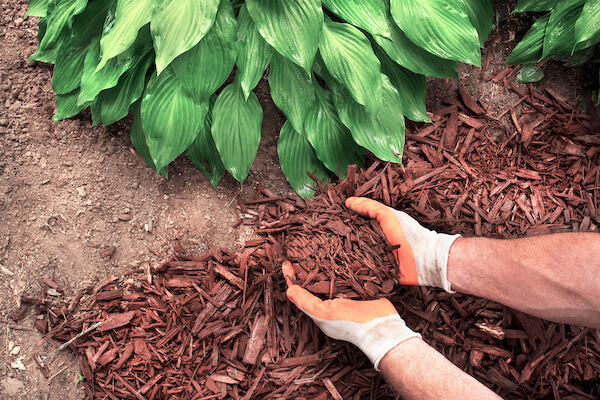Looking for ways to improve your lawn or garden this fall? Repurposing your colorful fallen leaves into mulch is a cost-effective way to ensure your landscape is healthy for next spring. Making leaf mulch yourself is easier than you’d think, but you can also make mulch out of:
- tree bark,
- grass cuttings,
- straw,
- shredded newspaper, and
- gravel or pumice rock.
Keep reading to learn more about healthy lawn care as we answer leaf mulch FAQs.
Is Leaf Mulch Acidic?
When leaves fall to the ground, they are slightly acidic. As time passes, the leaves return to a neutral level as they sit on the ground. However, a few varieties of leaves don’t mulch well. These leaves have natural herbicides that stunt plant growth instead of promoting it. Walnut tree leaves are among the most common leaf varieties containing these natural herbicides.
Can Evergreen Leaves be Used in Leaf Mulch?
Evergreen leaves typically take longer to break down than deciduous leaves, making it easier for leaf mold to develop. For this reason, evergreen leaves work better in compost, where microbes and decomposers are more active and effective at breaking down these leaves.
How is Leaf Mold Different From Leaf Mulch?
Both leaf mulch and mold result from shredding/chopping fallen leaves. We apply fresh leaf mulch to our soil to provide natural insulation at the base of our perennials and shrubbery.
In contrast, leaf shredding must age slowly to make leaf mold. The slow fungal breakdown of the leaves during the aging process results in a leaf mold that is excellent for gardeners with drainage issues and those who want to increase the friability of clay and hard soil.
How Long Does Leaf Mulch Last?
A good leaf mulch layer may last up to a year before decomposing to less than one inch. You may add the thin layer of remaining leaf mulch to your preferred topsoil or garden soil.
Leaf Mulch vs. Bark Mulch
Making leaf mulch yourself is an involved and lengthy process, and purchasing it from a supplier may become especially expensive depending on the size of your lawn and garden. However, bark mulch is highly accessible and inexpensive in comparison.
Bark mulch is decorative and is a popular choice in landscaping. It is excellent at retaining the moisture vital for your landscape’s grass, shrubbery, and plants.
Bark mulch does not mix with topsoil as effectively as leaf mulch can. For this reason, avoid turning your soil over as the bark mulch decomposes.
Additionally, manufacturers may color their bark mulch with inorganic dyes that may adversely affect vegetation. Check for synthetic materials and additives before committing to a new bark mulch.
What Is the Best Time to Spread Mulch?
Horticulturists and landscaping professionals recommend applying organic mulch after the third or fourth frost to prepare vegetation for the winter months. Generally, it is best to layer 4–5 inches of mulch around the base of trees and shrubs and 2–3 inches for perennials.
Gardens need some help coming back to life after all the winter freezes. Spreading 2-4 inches of your mulch of choice feeds vegetation and keeps plants healthy as the weather changes. Spend the rest of spring and summer enjoying the look and feel of a refreshed garden.
What Color of Mulch Is Best?
The different colors of mulch each have unique advantages and disadvantages. Take notice of your home and which style of mulch best fits your landscaping and aesthetic needs.
Consider the three most common mulch colors:
- Red mulch is a rust-like color and a top choice for brighter landscaping themes. It is ideal for complementing brick homes or buildings with red-toned siding. However, the dye for this mulch is synthetic and may stain concrete and stone.
- Brown mulch has excellent, long-lasting, neutral coloring that matches the exterior of most buildings. Its fade-resistant dye and ability to supplement various landscaping styles puts brown mulch in high demand.
- Black mulch provides a sharp and modern look for landscaping. However, its color naturally attracts more heat. If you live in a hot climate, consider an alternative that will keep the sun at bay.
Will Mulch Attract Bugs?
Mulch does not attract bugs on its own. However, it may create conditions where bugs can thrive.
For example, the decomposing mulch material provides a desirable environment for cockroaches, spiders, and mosquitos, which prefer cool and damp areas.
You can prevent significant bug problems by not layering too much mulch above your lawn and garden. Only apply the recommended 2-4 inches across your lawn property and around trees, shrubs, and perennials, allowing for proper drainage and insulation without trapping warm air and moisture in the soil.
Be Ready for Fall With EZ-POUR®
With winter weather just around the corner, it is time to prepare your lawn, and EZ-POUR® can help keep your yard maintenance on schedule with efficient and reliable replacement spouts and vent kits for your old gas cans.
Make refueling your lawn equipment quick, easy, and safe with nozzles that prevent spillage even with the most difficult of engines.
View our application chart to see which EZ-POUR® spout fits your old gas can. Then, place an order or find a retailer near you.

